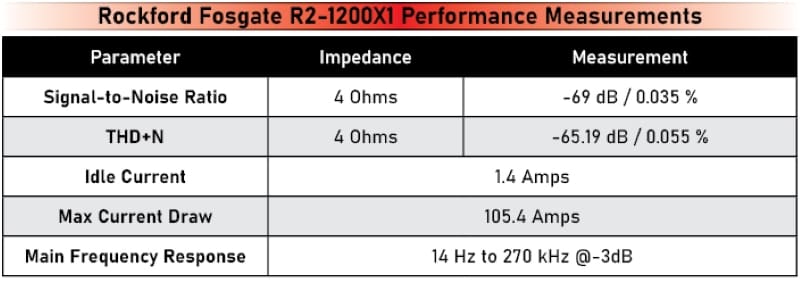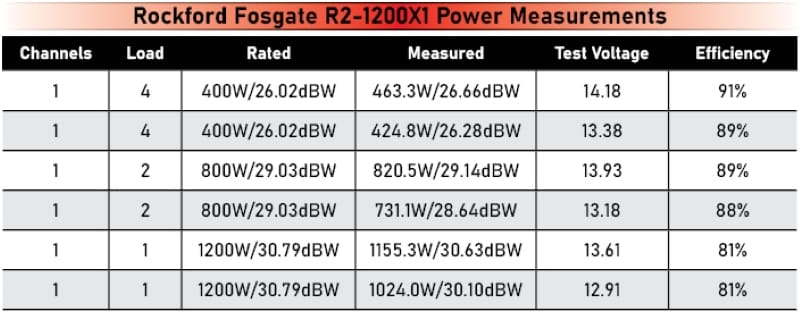As much fun as it is to test and audition high-end car audio products, we all know that a massive amount of business happens with more affordable products. Rockford Fosgate sent up one of their R2-1200X1 Prime Series 1,200-watt monoblock amplifiers for us to check out. This amplifier isn’t bottom-of-the-barrel inexpensive, and once you’re done reading this, you’ll understand what you get for a few extra bucks.
Physical Design of the R2-1200X1
The Prime Series products are the most affordable solutions from Rockford Fosgate. That’s sort of like saying the Macan is the least expensive Porsche. Uh, it’s still a Porsche. There are eight amplifiers in the Prime Series, and the R2-1200X1 is the biggest of the bunch. This amp is rated to produce 500 watts of power when connected to a 4-ohm load, 800 watts to a 2-ohm load and 1,200 watts when driving subwoofers with a net impedance of 1 ohm.
Physically, the amp features a cast aluminum heatsink. Cast aluminum heatsinks are significantly more expensive to produce than cut-to-length extruded designs. The key benefit is increased mounting locations for high-current devices and dramatically improved cosmetics. The R2-1200X1 measures 11.3 inches long, 6.8 inches wide and 1.9 inches tall.
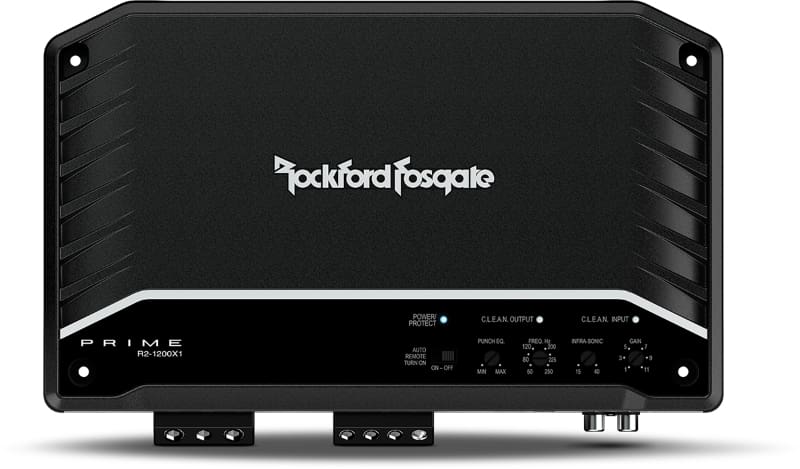
All the electrical and signal connections are made along the front edge of the amp. Angled terminal blocks with 3-mm hex-head set screws accept 4 AWG power and ground wiring. The speaker terminals include two positive and two negative locations to simplify wiring for multiple subwoofers. Each of the four locations can accept 8 AWG wire. A set of RCA input jacks on the right serve as the pre-amp level signal input connections, with pass-through RCA outputs beside them. A four-wire Molex plug accepts speaker-level input signals up to 12 volts.
All the controls are accessible from the top of the amp. This location requires a second circuit board, which adds to the manufacturing cost of the amplifier. On the far right of the controls is the sensitivity adjustment. It’s labeled from 1 to 11, allowing the amplifier to make full power with RCA signals between 0.15 and 4 volts. The RCA inputs include differential noise-cancelling circuitry. Internet amps rarely offer this feature. More importantly, differential inputs typically eliminate the need for your installer to fight to get rid of engine or alternator whine.
To the left of the sensitivity control is an adjustable infrasonic filter. The filter is a second-order -12 dB/octave Butterworth design that is adjustable between 15 and 40 Hz. Next is the crossover control, which uses -12 dB/octave circuitry. It’s adjustable between 50 and 250 Hz and can’t be defeated. Last but not least, you’ll find the Punch EQ control. Your installer can dial in a narrow bass boost centered on 45 Hz to add some kick to your woofers. The amp includes a switch that activates the Auto Remote Turn-On circuitry. If your installer has used the speaker-input pigtail, then the amp can monitor voltages on the wiring from the radio and turn itself on automatically.
Above the controls are three LEDs. The left-most LED illuminates blue when the amp is on or red when the NOMAD circuitry detects a fault. The next two LEDs are part of Rockford Fosgate’s C.L.E.A.N. distortion monitoring circuitry. The left LED illuminates when the amp reaches 1% distortion and the right illuminates when the input signal is optimized. Do inexpensive amps have these features? You bet they don’t! Many more costly amplifiers from other companies don’t have these time-saving features.
Rockford Fosgate includes a remote level control with the R2-1200X1. Your installer can mount this control in the front of the vehicle, so it’s easy for you to turn the bass up and down based on the music or your mood.
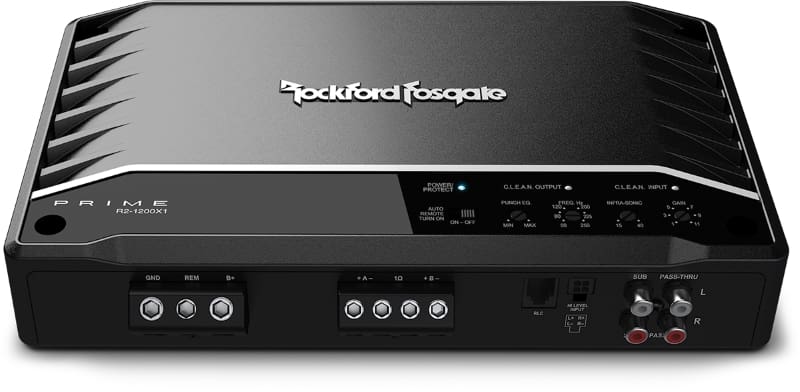
Inspecting Inside the Rockford Fosgate R2-1200X1
Removing the heavy-gauge bottom cover reveals a fairly typical Rockford Fosgate design. The circuit board is secured to the underside of the heat sink top panel. High-current devices are found along the heatsink’s back edge and one side. Aluminum blocks hold these devices in place and add additional mass to improve cooling. Those inexpensive or poorly designed amplifiers use small cooling fans that don’t blow air directly across hot devices – so they don’t work long when pushed hard. Rockford Fosgate’s high-mass heatsink design is among the most reliable.
The main circuit board and the one for the amplifier’s controls use surface-mount devices wherever possible to simplify the production process and improve reliability. Large capacitors and inductors have adhesive or silicone around their bases to ensure that they don’t vibrate and cause damage to the connections.
Current from the positive power input connection flows through a large-gauge choke before arriving at five 2,200-microfarad, 35-volt capacitors. The output voltage rails have six massive 3,500-microfarad, 100-volt capacitors to smooth ripples and store energy. The output filter on the Class D switching combines two ferrite core inductors with a pair of large polypropylene capacitors. As expected, the design is efficient and solid – just what we’ve come to expect from Rockford Fosgate.
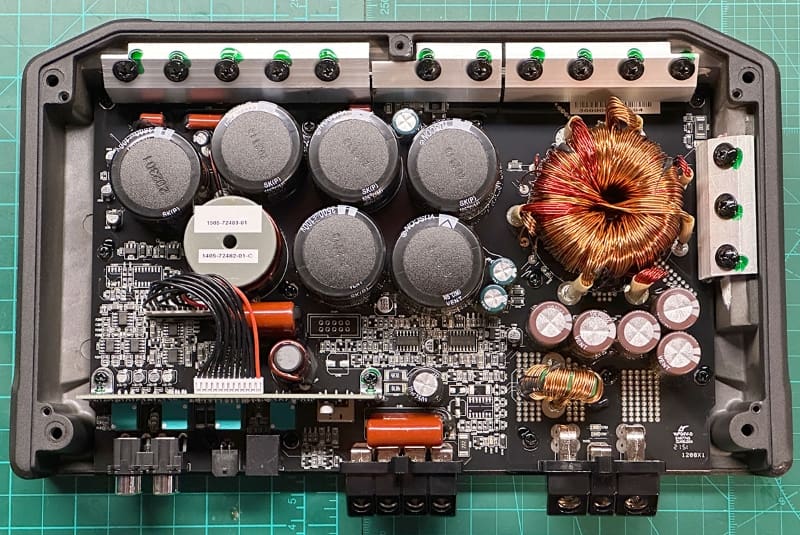
Auditioning the Prime Series 1,200-Watt Subwoofer Amplifier
Having tested a lot of subwoofer amplifiers over the years, I try hard to design audio systems that don’t load these amps down too much. In the case of the R2-1200X1, I’m using a 12-inch audiophile-grade subwoofer in a sealed enclosure for bass and a set of home audio bookshelf speakers powered by the reference full-range amp. I always adjust the amps I’m testing so the acoustic response in my listening room matches my target response curve.
I started with “The Chain” by Fleetwood Mac. The kick drum on this track is clean and clear, making it easy to pick out anything mucky or muddy in the bass. Likewise, John McVie’s fretless bass is a good challenge for both woofers and subwoofers. The solo, at three minutes, dips down to 40 Hz. Some of these older albums are a lot of fun. The R2-1200X1 reproduced the drums with good musicality. The thump sounded like a hammer hitting the skin of the drum. The bass guitar also had good detail.

Another acoustically challenging bass track is “Uh-Huh” by Thundercat. If you like complex bass guitar riffs like those from Les Claypool of Primus, then you’ll love Thundercat. Once again, the subwoofer and Rockford Fosgate R2-1200X1 did a good job of making the bass line sound realistic. You could hear the resonance of the strings well.
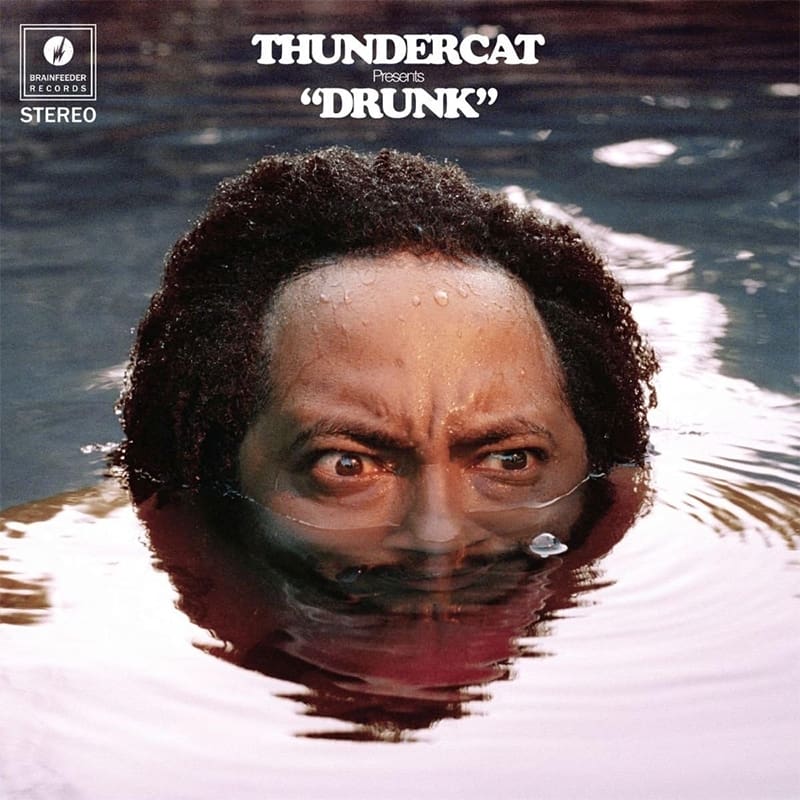
New Order’s “Blue Monday” is one of my go-to subwoofer system evaluation tracks. The bass kick should be tight and controlled. The Punch P300X2 I reviewed last winter was tighter and more dynamic than this Prime Series amp. Of course, a similarly powerful Punch Series amp like the P1000X1bd will cost 25% more. Nevertheless, the R2-1200X1 sounded good on this track, and it was fun to crank the volume and rattle the ceiling tiles in the listening room. Does it get two thumbs-up for bang-for-your-buck power? You know it does!

Bench Test Performance
With the listening done, I took the R2-1200X1 over to the bench to run it through my usual gamut of measurements. The first test was frequency response. When connected to a 4-ohm load and with the infrasonic and low-pass filter set at their lowest and highest ranges, I measured -3 dB frequencies of 14 hertz on the bottom and 270 hertz up top. As you can see from the graph, there’s a tiny roll-off of low-frequency information below 50 hertz. Because the attenuation doesn’t exceed 1 dB, it won’t be hugely noticeable in your vehicle and will offset some of the low-frequency cabin gain.
Regarding output regulation at different loads, a 2-ohm load impedance dropped the output by a tenth of a decibel at 100 Hz. A 1-ohm load dropped it another 0.05 dB. This performance is very good and shows that the amp has a low output impedance. Connecting the amp to my reactive load showed a response within two- or three-hundredths of a decibel across the operating range. Top notch!
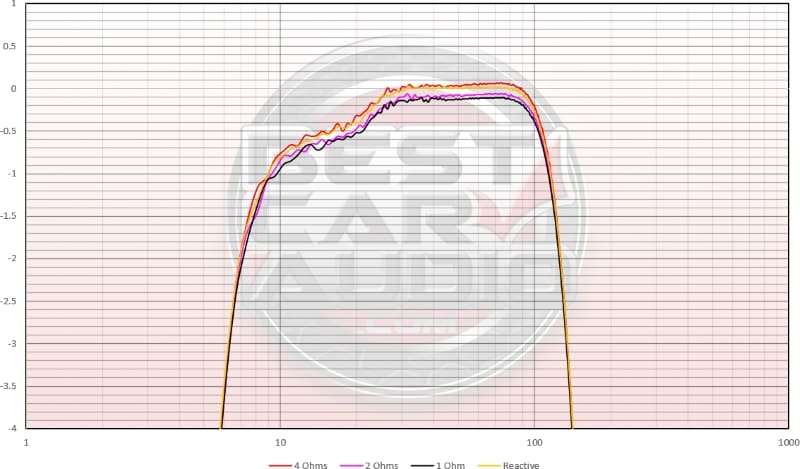
Measuring total harmonic distortion and noise, the R2-1200X2 added only 0.055% when driving a 4-ohm load. Impressively, it didn’t change much at 2 ohms. That’s a rare feat in subwoofer amplifiers and unheard of in an “entry-level” design. The signal-to-noise ratio measured at -69 dB is also very good.
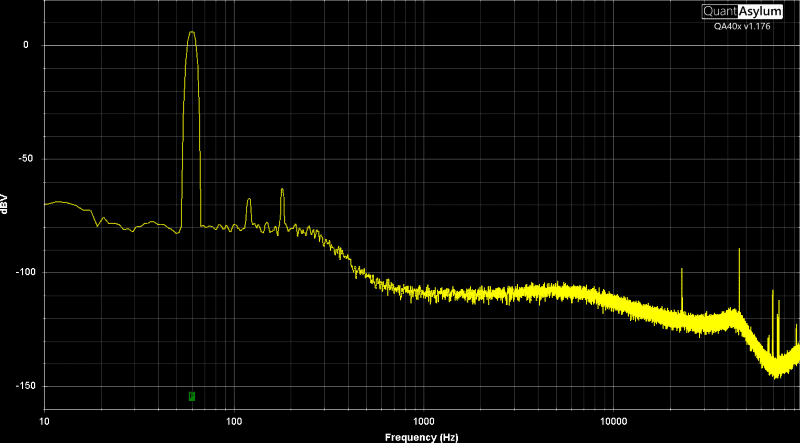
I measured the function of the built-in signal processing next. Starting with the low-pass filter, I took frequency response measurements with the control and both extremes of its range and a third in the middle. It’s nice that adjusting the filter doesn’t affect output in the pass band. Variations in the output based on crossover settings is a problem I see with many “cheap” amplifiers. This amp isn’t one of those.
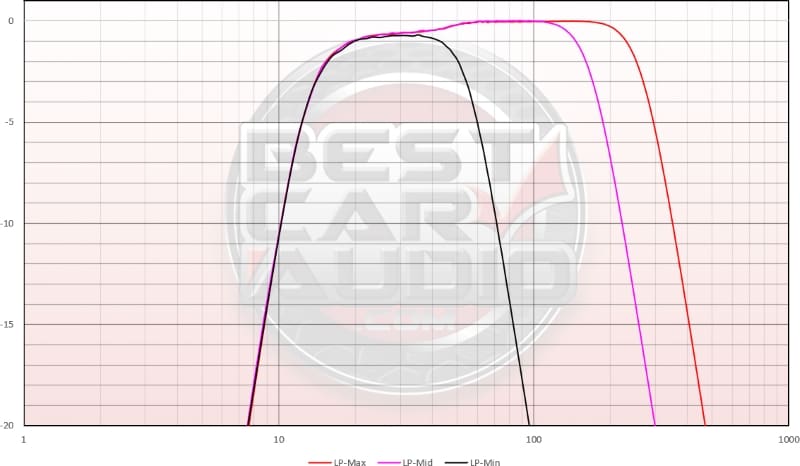
Looking at the infrasonic filter next, I took the same three measurements. Once again, the R2-1200X1 performed flawlessly. The different settings did not affect the output beyond where the filter functions.
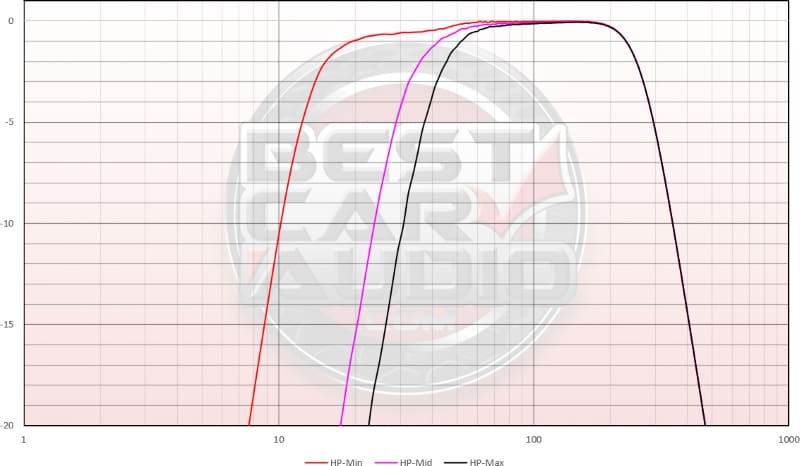
Lastly, we have the power production numbers. Power production seems to overshadow sound quality specifications in the market segment where the Prime Series amplifiers fit. We get it. We don’t like it, but we get it. The R2-1200X1 demonstrated that it could exceed its 4- and 2-ohm ratings with significantly less supply voltage than the 14.4 volts used in the ANSI/CTA-2006-D standard. It produced 1,155 watts into a 1-ohm load when provided only 13.6 volts. If I could up the supply voltage to 14.4 volts, it would exceed the 1,200-watt rating effortlessly.
What’s exponentially more important as a takeaway is the efficiency of this amplifier. When driving a 4-ohm load at maximum power, the amp is 91% efficient. At 2-ohm loads, it remains exceptionally efficient at 88 to 89%. Even when powering a taxing 1-ohm load, the R2-1200X1 maintained an efficiency of 81%. Most subwoofer amplifiers I’ve measured lose about 10% efficiency each time I cut the load impedance in half. This amplifier delivered exceptional performance in terms of efficiency. If you haven’t significantly upgraded your vehicle’s electrical system and want the most power possible for your subwoofers, I can’t suggest a better solution than the R2-1200X1 anywhere near its price point. It ranks with some of the best I’ve tested. Just plain WOW!
A Few Comments on Amplifier Efficiency
I want to put these efficiency comments into a clearer perspective. I tested another name-brand entry-level subwoofer amp for a private client a few years ago. This amp was rated to produce just a hair under 1,200 watts into a 1-ohm load. First, it only made 663 watts at 1% THD+N. Pushed up to the point that the amp illuminated the Clipping light on one of my D’Amore Engineering AMM-1 meters, it made 934.7 watts at only 57.6% efficiency. That amp was drawing 119.4 amps to produce 935 watts. The Rockford Fosgate R2-1200X1 consumed only 105.4 amps to produce 1,155 watts. It would need only 85.3 amps to produce the same power as the low-efficiency unit. Do you want 935 watts with 120 or 85 amps of current draw? That was a rhetorical question. Never mind.
So what happens when an amplifier isn’t efficient? It converts the current it consumes into heat. I ran the R2-1200X1 for 17 minutes at full power into a 1-ohm load without any issue from the amp. On the other hand, I think I damaged one of my load resistors as it exceeded 400 degrees. I had to stop the test at this point.
Oh yeah, that other amp mentioned above went into thermal protection in under two minutes while producing less power. Rockford Fosgate’s Maximum Efficiency Heat Sink Application (MEHSA) 4 heat sink design works well. Their power supply and output device design also work fantastically. Once again, bloody marvelous!
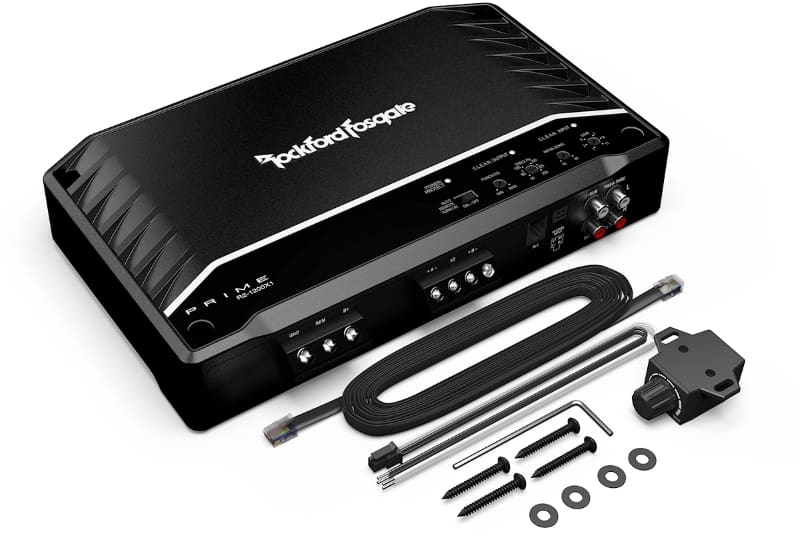
Conclusions on the Rockford Fosgate R2-1200X1
Have you ever wondered why name-brand amplifiers from companies like Rockford Fosgate cost a little more than those internet-only solutions? The answers are simple: Better efficiency, more features, improved cosmetics and class-leading customer service. Is the extra $50 to $100 for a Rockford Fosgate Prime Series amp worth it? You bet it is!
Rockford Fosgate has engineered their Prime, Punch and Power series products to all have the features car audio enthusiasts want. All their amps perform reliably. At similar power levels, they all play equally loud. The difference then comes down to their clarity. If you want an affordable, high-quality amplifier that will rattle mirrors and shake the seats, then the R2-1200X1 is the perfect choice. If you want more definition and clarity from your subwoofer system, then the Punch or Power amps are the next step up – that’s how “better” amps work.
I am thoroughly impressed with the R2-1200X1. From its classy cast aluminum heatsink and C.L.E.A.N. level-setting technology to its solid power production numbers and class-leading efficiency, you can’t go wrong if you want serious bass in your car, truck or SUV. Drop by a local authorized Rockford Fosgate retailer today to learn more about the Prime Series of car audio speakers, amplifiers and subwoofer. You can find a retailer near you using the locator tool on their website. Be sure to follow our car audio fanatic friends from Tempe on Facebook and Instagram to stay up to speed on their latest product releases and events. Be sure to check out their videos on YouTube, as they feature cool vehicles and amazing products combined with some of the best production quality in the mobile enhancement industry.

